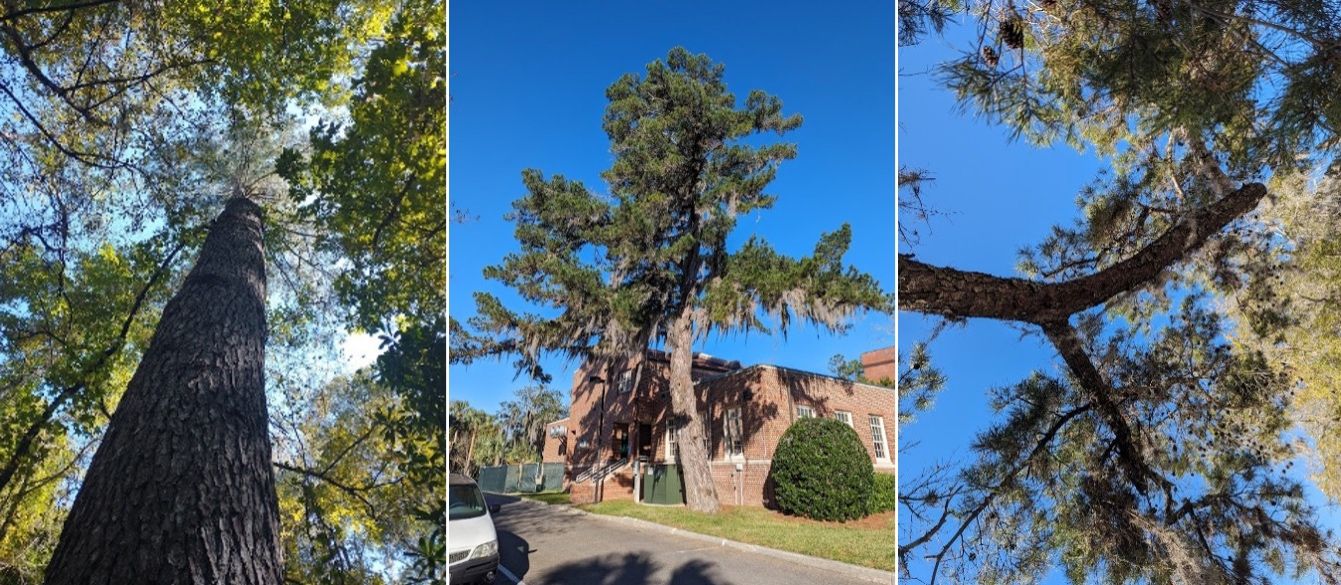
Credit: Allie Mitchell, UF/IFAS
This publication provides an in-depth profile of Pinus glabra for academic audiences and interested laypersons with some knowledge of biology.
Taxonomy
Family
Pinaceae, the pine family, includes 12 genera and 225 species. Characteristics of this family include small mature seed cones, winged seeds, and needle-like leaves. Members of the pine family are found naturally only in the northern hemisphere, but species of pine have been successfully cultivated in the southern hemisphere (e.g., South America, South Africa, and New Zealand) and are commercially important in those areas. Members of the Pinaceae family have been found in fossil records dating back to 200 million years ago and were likely a source of food for some dinosaurs.
Genus
Pinus is the only genus of the Pinaceae family with members native to Florida. All species within this genus found in Florida are evergreen (P. clausa, P. echinata, P. elliottii, P. glabra, P. taeda, P. palustris, and P. serotina).
Species
The species name glabra is from the Latin word “glabre,” meaning smooth. The name describes the bark of the tree, which is smooth in comparison to the bark of other Florida pine species.
Common Names
This species is most commonly referred to as spruce pine, but it has several other common names, including cedar pine, Walter pine, and bottom white pine. It resembles both spruce and white pine, and it tends to be found on moist hardwood sites, such as swamps, river valleys, bottomlands, and hammocks (Figure 2).
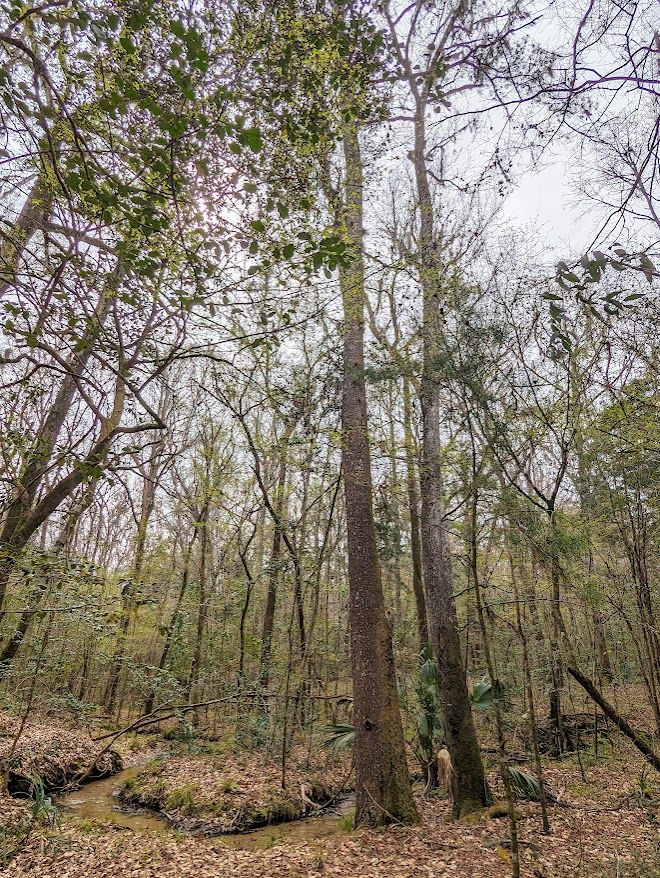
Credit: Allie Mitchell, UF/IFAS

Credit: This image was acquired from Wikimedia. It was marked as Public Domain or CC0 and is free to use. To verify, go to the source, https://free-images.com/display/pinus_glabra_range_map.html
Description
Spruce pine is a slow-growing, medium to large conifer found along the southeastern Coastal Plain from Louisiana/Mississippi to the Atlantic coast of South Carolina/Georgia and south into Florida (Figure 3) (Kossuth and Michael 1990). In Florida, it is mostly found in the Panhandle and northern portions of the peninsula.
Spruce pine is a highly shade-tolerant species often found within moderately to poorly drained sites such as in bottomlands and hardwood hammocks and along the slopes of ravines and creeks (Figure 2) (Sullivan 1993). Spruce pine rarely forms pure stands. Instead, it is commonly found at low densities in these areas. While it may be found on wet sites, it generally does not tolerate areas that flood for prolonged periods of time. Spruce pine is included as a constituent species in the descriptions of three Florida Natural Area Inventory plant communities: upland hardwood, slope forest, and bottomland forest (see the Florida Natural Areas Inventory (FNAI) for more description) (Florida Natural Areas Inventory 2010). These sites do not experience fire regularly, and spruce pine bark is therefore relatively thin compared to the bark of other southern pines, resulting in a low fire tolerance for the species.
Spruce pine needles are in fascicles of two. They are twisted and grow to a length of 1.5 to 4 inches (Figure 4) (Bean 2021). The bark is thin and reddish grey-brown, with tight, irregular, shallow fissures (Figure 5) (Kossuth and Michael 1990). Higher up the bole (trunk) of the tree, the bark changes and is often smooth and gray (Proctor and Morrow 2019). Spruce pine bark is unlike the bark of other southern pine species. It more closely resembles the bark of spruce trees (Picea spp.) or hardwoods, such as some oaks (Quercus spp.) or mature black cherry (Prunus serotina). Female cones are small, only 1.5 to 3 inches (4–8 cm) long and will remain on the branches for three to four years (Figure 6) (Proctor and Morrow 2019; Gilman and Watson 2015).
At maturity, spruce pine can reach heights of 90 to 100 feet tall (27–30 meters) with an average diameter of 24 to 36 inches (61–91 cm) when found in its natural habitat (Sullivan 1993). When it grows in full sunlight, as frequently when it is grown on urban sites, spruce pine usually reaches heights of only 30 to 50 feet tall at maturity (Gilman and Watson 2015).
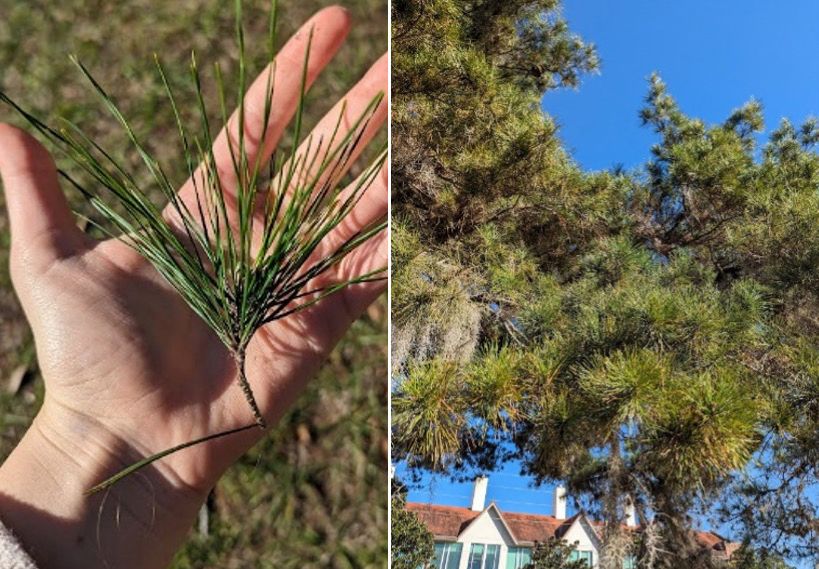
Credit: Allie Mitchell, UF/IFAS

Credit: Allie Mitchell, UF/IFAS
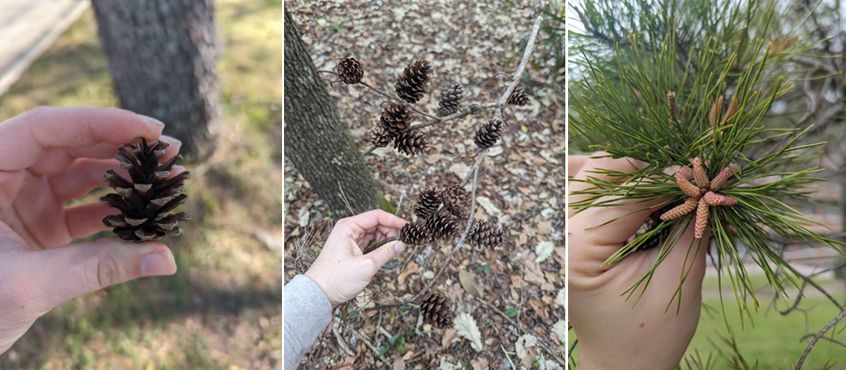
Credit: Allie Mitchell, UF/IFAS
Allergen
Species within the genus Pinus commonly produce large amounts of pollen each year. However, the pollen is waxy and not highly irritative, making their potential for allergy low (Ogren 2001). Reactions to the scent of Pinus species have been reported but are also rare (Ogren 2001).
Storm Tolerance
Spruce pine has the lowest wind resistance of all the southern pine species (“Hurricane Resistance of Trees” 2018). The wood is known to be brittle, and the taproot is typically moderately deep (Kosuth and Michael 1990).
Pests and Disease
Spruce pine is susceptible to attack by bark beetles, specifically the southern pine beetle (Dendroctonus frontalis) (Hain et al. 2011). However, because spruce pines usually do not grow in pure stands, they tend not to experience large bark beetle outbreaks throughout the population. It should be noted, though, that there is limited research on this interaction, and some research suggests that spruce pine is a preferred host for the beetle (Chelman and Wilkinson 1975).
Spruce pine is one of the main hosts of gall mites in Florida (Trisetacus floridanus). These mites attack terminal shoots, shortening the shoot and causing the tree to form galls (Kossuth and Michael 1990). Spruce pine is also one of the main larval hosts in Florida for various sawfly species (Neodiprion spp.), including the more common blackheaded pine sawfly (N. excitans) and the less common N. warreni (Ridenbaugh et al. 2023; Dixon 2023). Pine sawflies deposit their eggs in the needle tissue and then feed on the needles after they hatch (Ridenbaugh et al. 2023; Dixon 2023).
Spruce pine is resistant to fusiform rust (Cronartium quercuum f. sp. fusiforme) (Kossuth and Michael 1990; Simons 2021). Canker diseases may cause dieback but are not a significant threat to spruce pine (Gilman and Watson 2015).
Lightning is the most common cause of death for spruce pine trees because they are so often the tallest single trees in the hardwood areas where they typically grow (Simons 2021).
Applications
Forestry/Commercial
Spruce pine is of limited commercial value in the United States due to the brittle, close-grained, and resinous nature of the wood (Kossuth and Michael 1990; Sullivan 1993). It can be used in limited quantities as it occurs for pulpwood. When grown in full sunlight, spruce pine boles/stems typically grow twisted, crooked, and more compact. For this reason, it is not grown on a significant scale in a plantation setting, although it is planted for use as a Christmas tree in some regions of the southeastern United States (Kossuth and Michael 1990).
Wildlife
Squirrels, northern bobwhite quail, and other mammals are known to use spruce pine seeds as a food source (Sullivan 1993). However, spruce pine is favored less in comparison to other southern pines. Raptors and pileated woodpeckers use spruce pines as nesting sites (Simons 2021).
Ornamental Use and the Urban Setting
Spruce pine is planted to a limited extent for use in urban settings, primarily for use as a shade tree (Figure 7). The unusual, twisted growth of spruce pine in full sunlight also has an aesthetic appeal.
Spruce pine grows best in fertile soils, and yet it is not recommended to be planted in soils with high pH values (Gilman and Watson 2015; PLANTS Database, n.d.; Kluepfel and Polomski 2020). While naturally found on sites with moist soils (moderate to poorly drained), spruce pine will tolerate dry soils in urban settings as well.
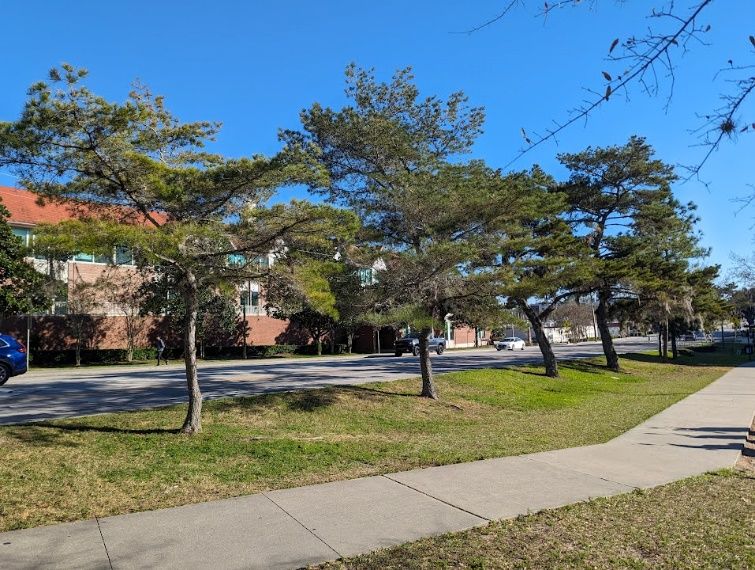
Credit: Allie Mitchell, UF/IFAS
A Note about Research
Relative to commercially important southern pine species (P. elliottii, P. palustris, or P. taeda), spruce pine is poorly studied, and current scientific literature is limited.
Works Cited
Bean, R. 2021. Differentiating Between Loblolly, Longleaf, and Other Southern Pines in the Woods. Clemson Extension Forestry and Wildlife. https://blogs.clemson.edu/fnr/2021/07/20/differentiating-between-loblolly-longleaf-and-other-southern-pines-in-the-woods/
Chellman, C.W., and R. C. Wilkinson. 1975. “Recent history of southern pine beetle, Dendroctonus frontalis Zimm., (Col.; Scolytidae) in Florida.” Florida Entomologist 58: 22. https://doi.org/10.2307/3493861
Dial, S. C., W. T. Batson, and R. Stalter. 1976. “Some Ecological and Morphological Observations of Pinus glabra Walter.” Castanea 41 (4): 361–377. http://www.jstor.org/stable/4032730
Dixon, W. N. 2023. Pine sawflies, Neodiprion spp. (Insecta: Hymenoptera: Diprionidae). EENY317. Gainesville: University of Florida Institute of Food and Agricultural Sciences. https://edis.ifas.ufl.edu/publication/IN592
Florida Natural Areas Inventory. 2010. Natural Communities Guide. https://www.fnai.org/species-communities/natcom-guide
Gilman, E. F., and D. G. Watson. 2015. Pinus glabra: Spruce Pine. ENH625. Gainesville: University of Florida Institute of Food and Agricultural Sciences. https://edis.ifas.ufl.edu/publication/ST466
Hain, F. P., A. J. Duehl, M. J. Gardner, T. L. Payne, and R. N. Coulson. 2011. “Natural History of the Southern Pine Beetle,” in Southern Pine Beetle II, edited by R. N. Coulson and K. D. Klepzig, 13–24. General Technical Report SRS-140, Ashville, NC: U. S. Department of Agriculture Forest Service, Southern Research Station.
Hurricane Resistance of Trees. 2018. UF IFAS Blogs. https://blogs.ifas.ufl.edu/pinellasco/files/2018/03/wind-resistantance-of-trees.pdf
Kluepfel, M., and R. F. Polomski. Pine Factsheet. Clemson Cooperative Extension Home and Garden Information Center. https://hgic.clemson.edu/factsheet/pine/ (2020)
Kossuth, S. V., and J. L. Michael. 1990. “Pinus glabra Walt,” in Silvics of North America, Volume 1, edited by R. M. Burns and B. H. Honkala vol. 1, US Department of Agriculture, Forest Service.
Ogren, T. L. 2001. Allergy-Free Gardening: The Revolutionary Guide to Healthy Landscaping. Berkeley: Ten Speed Press.
PLANTS Database. Pinus glabra Walter. USDA Natural Resources Conservation Service. https://plants.usda.gov/home/plantProfile?symbol=PIGL2
Proctor, N., and M. Monroe. 2019. Common Pines of Florida. FOR21. Gainesville: University of Florida Institute of Food and Agricultural Sciences. https://edis.ifas.ufl.edu/publication/FR003
Ridenbaugh, R. D., A. N. Glover, and C. R. Linnen. 2023. “First Record of the Pine Sawfly Neodiprion warreni (Hymenoptera, Diprionidae) in the State of Tennessee and on Pinus virginiana.” Journal of Hymenoptera Research. 96:937–947. https://doi.org/10.3897/jhr.96.112395
Simons, R. W. 2021. “Spruce Pine – Pinus glabra,” in The Ecology of the Trees, Shrubs, and Woody Vines of Northern Florida. 1st ed., 32–34 Gainesville: University Press of Florida https://doi.org/10.2307/j.ctv1t1kg94
Sullivan, Janet. 1993. Pinus glabra, in Fire Effects Information System. U.S. Department of Agriculture, Forest Service, Rocky Mountain Research Station, Fire Sciences Laboratory (Producer). https://www.fs.usda.gov/database/feis/plants/tree/pingla/all.html